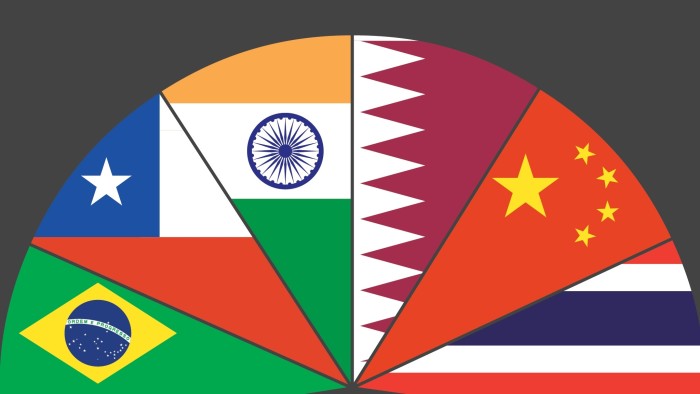Redefining EM: Country clusters offer new matrix

Roula Khalaf, Editor of the FT, selects her favourite stories in this weekly newsletter.
The question of what constitutes an emerging market has haunted me for decades. Since 1989, the World Bank has defined an emerging market as a country with a GDP per capita ceiling of $13,000 or less. But gross domestic product is simply a “wealth” statistic. A country with $12,999 in GDP per capita is very different from one with $1,500.
Thus a new, multi-dimensional method of classifying emerging markets is called for, one that takes into account a cluster of different indicators to produce a ranking of countries’ socio-economic maturation.
Having traded in and taught about these countries for more than 20 years, I have witnessed immense progress among many emerging markets, but often this progress has not been fully appreciated by either the providers of financial indices or investors.
I started asking myself, besides GDP, what are the other dimensions that define a country’s maturation? Are there more objective ways to analyse and cluster countries? Are not countries more nuanced than the blunt descriptions “advanced” and “emerging”? My gut feeling was yes, but I needed an objective, “big data” framework to answer these big questions.
Last year I probed these questions using Ward’s Method, a quantitative approach that clusters things based on the “minimum variance” of certain factors — that is, grouping things whose qualities were statistically most similar.
My idea was to batch 100 countries (both advanced and emerging) into 10 clusters. Group 10 would have the highest scores awarded for nine specific criteria, denoting more mature countries that may be more resilient to potential shifts and shocks. Group 1 would have the lowest scores, signifying those countries that are less mature and more vulnerable to an array of risks.
The members of each group were arrived at by assigning numerical values to each country reflecting the nine distinct categories. Thus a country with a high per capita GDP would be given a high score in the category concerned with this metric. The other eight categories include two for population size and competitiveness, three for credit ratings, stock market penetration and currency valuations, and three for heath, education and political climate.
I compared year-end 2003 and year-end 2013, offering a view on the changes that took place over an important decade of globalisation that embraced the five years leading up to the 2008 crisis, and the five years following it.
The results were fascinating.
First, the numerical scores from five economies did not cluster with any group because of outsized endowments in one or more areas. These countries included the US, which defied the cluster because of its large and wealthy population; China, which did not cluster because of its huge population; India, which did not fit because of its large population and many differences with China; Hong Kong, which was anomalous because of its combination of high wealth, strong financial development and small population; and Qatar, which is an outlier because of its wealthy and small population.
Second, most “emerging” countries rose up the ranking during the decade while some “advanced” economies slipped. The result was a bunching-up in the 5th-8th clusters from 27 countries in 2003 to 47 in 2013. Among the big advancers were Ghana, which climbed from Group 1 to Group 6, while big losers included Iceland, Ireland, Italy and Spain, which all slipped from Group 10 down to Group 8. Cyprus and Greece slid from Group 9 to Group 7. The two big surprises came from the Middle East, with Kuwait and the United Arab Emirates dropping from Group 8 to Group 4.
One insight the study throws up is that it may be instructive to view the development of countries as a continuum in which each stage of socio-economic progress may not be perceptibly different from each other, though the extremes are quite distinct.
Indeed, because many “emerging” countries have closed many socio-economic gaps and converged with “advanced” ones, it is now tough to say where “emerging” ends and “advanced” begins.
FT Series

As emerging markets overtake developed ones in some areas the FT investigates whether it is time to coin a new phrase for the developing powers
Another insight is that so-called emerging markets are now generally more mature than they were a decade ago and too big for investors to ignore. They contribute more than 50 per cent of global output on a purchasing power parity basis, most have robust “investment grade” credit ratings and have fast-growing financial markets.
China’s dramatic rise is also noteworthy. It has a credit rating similar to or better than most advanced economies (AA minus), while also having the world’s second-largest stock market and an economy that ranks second in size to the US in nominal terms.
These dimensions — combined with the fact that its economy is almost as large as all other emerging markets combined — argue for removing China from its current classification as an emerging market and creating a separate category for it alone.
The only country that is remotely comparable to China is the US.
Peter Marber is head of emerging market investments for Loomis, Sayles & Company. He also teaches at Harvard University and his latest book is ‘Brave New Math: Information, Globalization, and New Economic Thinking in the 21st Century’
Comments